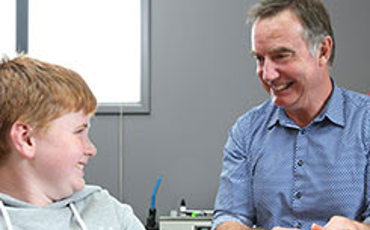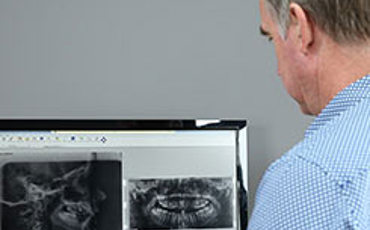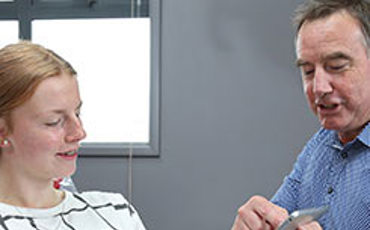As a specialist orthodontics practice, we're totally focused on providing you with the very best orthodontic care.
Whether you have a bite problem, a crowded mouth, or a desire to smile again - we look forward to helping you restore your confidence. Orthodontic treatment can help improve your oral health as well as your overall health.
You can completely transform your smile with straight teeth, that's why we offer a range of options to help you achieve the happy, healthy smile you deserve.
Our Process

The purpose of the initial consultation is to identify and diagnose each patient’s unique issues. This appointment includes a clinical examination prior to discussing individual needs and desired outcomes and expectations.

We use state of the art digital technology to assess any orthodontic issues and address concerns. This appointment usually includes specialised x-rays, photos of your teeth and face, and the creation of a 3D set of models of your teeth.

We create a treatment plan specific to each patient. This can involve a number of facets and phases. Dr Kieran O'Neill will discuss this treatment plan in detail with you and answer any questions you may have.
Treatment Overview
The length of treatment varies considerably from patient to patient. It's not only about improving the aesthetics of your smile but about how you feel about yourself.
Seeking orthodontic treatment early can prevent some conditions from worsening to a point where more extensive solutions may become necessary. This is called ‘interceptive treatment’.
Common Early (Interceptive) Treatments:
- Removable plates
Can correct simple tooth crossbites or posturing underbites, allowing other erupting adult teeth to erupt into their usual positions.
- Expanders
Designed to increase the width of the upper jaw, improving the bite (e.g. crossbites) and providing more room for the developing teeth
- Functional (Orthopaedic) Appliances
Use the growing jaws, especially, the lower jaw, to help reduce the relative protrusion of the top front teeth.
- Space maintainers
To avoid loss of space for the second, adult tooth, a space-maintaining device is usually indicated.
Some of the benefits:
-
After interceptive treatment, you will be able to create room for crowded, erupting teeth
-
You will reduce the risk of trauma to protruding front teeth
-
Interceptive treatment helps preserves space for unerupted adult teeth
-
You can help to reduce the possibility of adult tooth removal
-
Interceptive treatment reduces your treatment time with braces
-
You can eliminate crossbites that can have effects on developing teeth
-
Treatment helps manage thumb or digit sucking, or other habits that can influence the positions of erupting teeth
Children
Initial treatment involves the fitting of an appliance - sometimes called a ‘plate’, which needs to be worn all the time over a period of between six to nine months with regular monthly visits to the clinic. After this initial phase, the plate may be worn at nights for a period of up to 2-3 years, or until all permanent teeth have developed.
In some cases additional orthodontic work may be required to deal with any adult teeth that may be misaligned or rotated.
Teenagers
Most comprehensive orthodontic treatment starts in the early teen years (11-15). Starting at this time allows us to provide the best treatment for every patient and also potentially reduce the overall length of treatment, as in the teenage years facial growth and development is still underway.
Having orthodontic treatment as a teenager is also about having fun with braces. Our patients can chose colours to match their favourite clothes, support their sporting team or just because they look great! For those who don’t want the appearance of braces there is also the option of tooth coloured brackets and transparent (clear) aligners to keep the teeth looking fresh while your new smile is being created.


Treatment Options
- Metal braces
These are smaller and less obtrusive than they used to be. Traditional metal braces are the most common type of braces and are used on all age groups. Constructed of high-grade stainless steel, they are bonded/glued to your teeth and straighten your teeth using arch wires.
- Ceramic braces
Work exactly like normal metal braces, the only difference being that the brackets are made out of a very fine translucent tooth-coloured porcelain which make the braces almost invisible (hence they are also known as ‘clear braces’ or ‘invisible braces’). They are popular with older teenagers and adult patients who may have cosmetic concerns.
- Invisalign®
Invisalign clear aligners now allow almost invisible straightening of teeth using sets of see-through aligners. The major benefits – apart from being unobtrusive – is that:
-
They are customised to your teeth
-
You don’t have metal brackets or wires that can irritate your mouth and gums
-
They can be easily removed whenever you need to brush your teeth, or eat and drink
-
- Orthognathic Surgery
Orthognathic surgery, also known as corrective jaw surgery or surgical orthodontics, may be required to correct abnormalities of the jaw sizes and/or positions that cannot be addressed using standard orthodontic treatment methods alone.
Using the latest in digital imaging technology we can assess the functional and aesthetic benefits of orthognathic surgery combined with braces. We use computerised treatment planning to help minimise treatment times and recovery periods and enhance the overall effectiveness of your surgery. State-of-the-art materials such as titanium plates and miniature screws provide stability, strength and predictability to your treatment.
Treatment includes standard orthodontics before and after surgery and may take a number of years to complete. Your orthodontist will give you a realistic estimate of the time required for your treatment to complete.
Orthodontic Problems
Crossbite
A condition where the upper teeth do not ‘fit’ with the lower teeth when the teeth come together.There are many approaches that can be taken to correct cross-bite, including fitting braces and fixed or removable plates.
Crowding
A condition where there is not enough space in the mouth for the normal number of adult teeth. Although crowding may be noticed at a young age - even in children as young as six - this crowding may improve with age, .since the jaws continue to grow after the adult front teeth erupt.
Protruded teeth
An orthodontic term for what is known as ‘buck teeth’, namely where the front teeth at the top jut out from the mouth. Having protruded teeth may make them more prone to damage and injury, and may cause problems with speaking and eating and can look unattractive.
Thumb sucking
Is a natural reflex and it is normal for children to stop sucking thumbs and fingers between the ages of 2 and 4 years old. If thumb sucking does continue after the first adult teeth have come through (normally around the age of 6 or 7), it may contribute to teeth being pushed out of alignment.
Missing teeth
Teeth may be missing for a number of reasons. In some cases, individual teeth simply don't develop from birth, or injury causing loss of a tooth or tooth decay/removal. Although having teeth missing doesn't necessarily require dental or orthodontic treatment, it can be highly recommended. If the baby teeth are still present; are in the bite, have their usual root structure, and no decay or fillings they can often last for several more decades longer than when they usually fall out.
Open bite
A condition where the top and bottom set of teeth do not meet at all, leaving a gap. It can be difficult to correct and is best assessed as soon as it appears, which is often at a young age when the development of the jawbones can be monitored and positioning of the teeth can be more easily controlled.
Deep-bite
Describes the situation where the upper front teeth bite down over the lower teeth. It can cause significant wearing of the teeth and make biting and chewing difficult. The gums behind the upper teeth and in front of the teeth below can also be affected.
Spaced teeth
Spacing is the opposite of crowded teeth, where there are visible and sometimes large gaps between the teeth – sometimes known as ‘gapped teeth’. Most gaps between the upper front teeth often close on their own once all the adult teeth have emerged although it is worth consulting an orthodontist if this hasn’t happened by around the age of 12.
Under-bite
Describes where the teeth in the lower jaw come to rest in front of the teeth in the upper jaw when the teeth come together. It is a relatively uncommon condition and is generally inherited. However, it can cause problems such as tooth wear and difficulty biting and chewing when eating, and teeth can rotate or become angled as the mouth adapts to the under-bite.